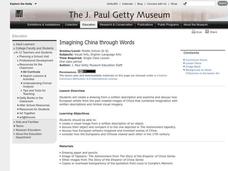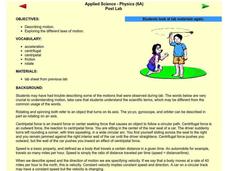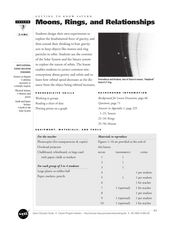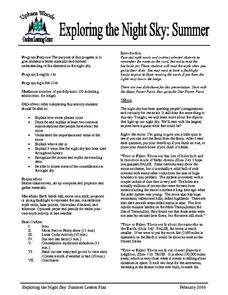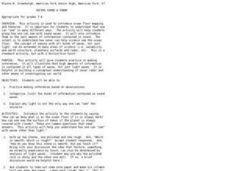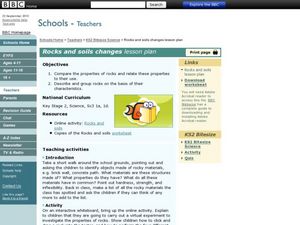Curated OER
Many Uses of Plants
Students research and discuss non-food plant products that are in common use, and mark on a world map the name of the country where the plant is grown.
Curated OER
The North (Wall) Star
Young scholars engage in a lesson which shows them that celestial navigation is the art and science of finding one's geographic position by means of astronomical observations, particularly by measuring altitudes of celestial objects -...
Curated OER
Brett Whiteley
Students employ a PowerPoint to publish an Interactive Multimedia Information Kiosk, where students can click on an object to gain more information or branch to different locations. They publish information that is exciting, dynamic and...
Curated OER
Living or Non-Living
Students examine living and non-living things. In this life science lesson, students are given a group of objects and discuss if they are living or non-living. Students identify and list characteristics of living things.
Curated OER
Imagining China Through Words
Students create a drawing from a written description to examine images of China in European art. For this art analysis lesson, students create a visual image from a written description of an object. Students compare their image to the...
Curated OER
Laws of Motion
Young scholars explore centrifugal and centripetal force. In this motion lesson, students expand on their knowledge of motion to study velocity, acceleration, and friction. Young scholars examine multiple objects to demonstrate the laws...
Curated OER
Getting to Know Saturn: Moons, Rings, and Relationships
Students identify the different objects that orbit Saturn. In this space science lesson, students plot the graph of orbital speed and distance. They explain why planets and asteroids remain in orbit around the sun.
Curated OER
Magnetic Field Activities
Students explore the idea of magnetic field through investigations of magnetic fields as produced by various common magnetic materials and direct currents. They study the vector nature of fields, the ubiquity of field sources in the...
Curated OER
Exploring the Night Sky: Summer
Students explain how moon phases occur. They describe and explain at least two common misconceptions that people have about the moon. Students explain what a star is. They explain 3 ways that the night sky has been used throughout history.
Curated OER
Subtraction (Single Digits)
First graders demonstrate subtraction process using an object (fish scales), set up a subtraction problem using fish scales, and apply the subtraction sign when separating sets of objects.
Curated OER
States of Matter
Fourth graders define the term matter. They compare properties of solids, liquids, and gases. They describe how matter changes from one state to another. They classify objects as either solid, liquid, or gas.
Houghton Mifflin Harcourt
Explore Customary Units of Length - Practice 12.1
Give pupils a ruler and this worksheet so that they can practice measuring down to the quarter inch! Drawings of six various objects are depicted for them to apply their measurement skills to. The assignment concludes with one...
Curated OER
Seeing Sound & Sonar
Students make inferences based on different sounds that they hear. In this inferences lesson plan, students will hear sounds of different objects and describe the sounds based on what they hear. They will answer various questions about...
Curated OER
Rocks and Soil Changes lesson plan
Learners recognize objects around their school made of rocky materials. In this changes in rocks and soil lesson, students use a website for a virtual experiment of rocks. Learners group rocks based on their properties....
Curated OER
Fraction Fun
Students practice identifying common fractions using various manipulatives. They visit a visual fractions website and complete an activity. In the final activity, students create real-life problems.
Curated OER
Sharks in Decline
Students investigate common fishing methods used to capture sharks. They decide why these methods and the shark's reproductive biology are contributing to the quick reduction in the shark population.
Curated OER
What a Drag
Students learn examples of friction and drag, and suggest ways to reduce the impact of these forces. The equation that governs common frictional forces is introduced, and during a hands-on activity, students experimentally measure a...
Curated OER
Fraction Fun
Learners define properties of fractions and solve for them. In this algebra lesson, students rewrite fractions from mixed numbers to improper fractions. They reduce fractions using the GCF and convert the denominators correctly when...
Curated OER
Applied Science - Built Environment (3) Pre Lab
Third graders discuss types of transportation. In this transportation lesson plan, 3rd graders discuss common ways people get around and the effect of electric energy on our society. They write a paragraph about different kinds of...
Curated OER
What Is It?
Play the game of Tag and differentiate between plants and animals. Explore the characteristics of plants. Identify the major parts of plants (e.g., seeds, stem, pistil) and describe their basic functions. Compare the requirements of some...
Curated OER
Garden Grid
Basically, your class reads about different garden plants from an included handout and seed packets that you provide, and then uses a grid to plan out where to place the plants. They can practice counting with the seeds, grouping,...
Curated OER
Documentarians of an Era: A Study of the Paintings of Thomas Eakins and Gustave Caillebotte
Students produce an object analysis of 'The Champion Single Scull'. They begin with description, proceeding to deduction, and finally providing speculation by interpreting the outward evidence of culture. They use a clipboard and paper...
Curated OER
A New Slant On The Seasons
Students identify how the tilt and position of the Earth causes the seasons. After a discussion of the seasons and when they begin. Using themselves as the objects in the universe, they role play how the rotational movement of the...
T. Smith Publishing
Counting on the Farm
Hee-haw! Preschool or kindergarten math pupils identify and count different objects in a lively farm landscape. Beneath the picture, each animal or plant is represented pictorially, and little ones simply write the total count for each....




